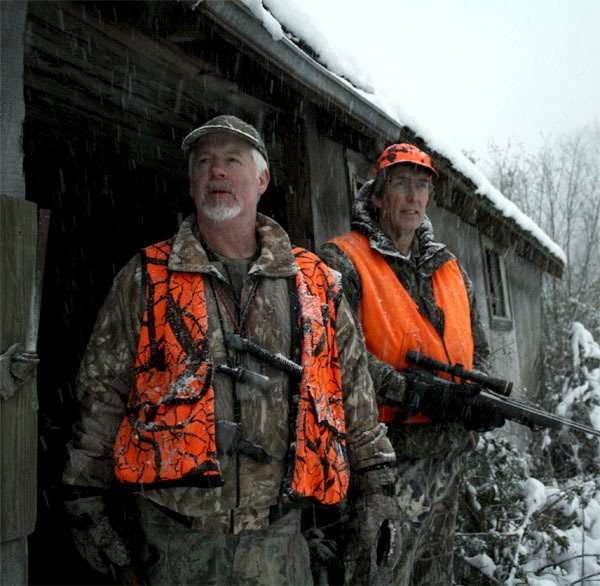Dusk fell quietly as David Wyrick and Steve Perry took their positions inside the barn and readied their rifles. Motionless, without speaking, the men settled in their darkened blind, waiting for the perfect moment to make a kill.
Both men are master hunters, allowed to kill one cow elk this fall in a culling project approved by the Washington Department of Fish and Wildlife. Their vantage point, a cow shed near the Snoqualmie River’s Three Forks, allowed them a view onto a nearby pasture. Mist-wreathed trees in the distance marked the extent of their kill zone. The men only had a hundred yards or so to make a safe shot, and as master hunters, that is the only one they are allowed to take.
“If there is any question about it, you don’t have a shot,” said Perry, a Carnation resident and master hunter of eight years. “Our number one thing here is safety, and relations with landowners and neighbors. We’re in their back yard.”
Earlier, North Bend resident and Master Hunter Coordinator Jim Gildersleeve met with the hunters to show them the lay of the land and how to do their job safely.
“It’s important that they understand this area,” said Gildersleeve, who works with hunters to find permitted, private sites.
At the Scott farm at Three Forks, Gildersleeve explained how topography and a nearby road defined safe and unsafe shooting lines. From the barn, the men had an ideal view. Poised to waylay passing elk, the hunters were aiming downhill; any missed shot would pass harmlessly into the earth.
Keeping herd level
This year, hunters have been authorized to kill 42 cows, with master hunters receiving 25 permits. So far, nine elk cows have been killed.
Gildersleeve is expecting a good season, and the Scott property is a good place for a hunter to hide. The riparian habitat is prime elk country, but the animals don’t respect property boundaries, leading to increased run-ins with residents and property owners. This fall, Nursery at Mount Si owner Nels Melgaard canceled autumn activities and closed his pumpkin patch because a nocturnal herd had destroyed the field.
When combined with accidents, predation and natural causes, the hunt is believed to keep the Valley herd stable in size, more spread out and more averse to human beings.
“The goal right now is to keep it level,” said Gildersleeve. A major study of elk habits and numbers is underway, and a constant population will help in getting that data, he said.
Elk have overbrowsed the Valley floor, Gildersleeve said.
“If we don’t keep the numbers under control, we’re going to have significant die-off, especially in a hard winter,” he said.
Hunted for the first time last year, the herd has already become more wary of humans.
“That’s a good thing,” Gildersleeve said. “That keeps the distance between the humans and the animals, and minimizes a lot of problems.”
Hunters must dress in orange, and hunt in permitted areas. They cannot shoot in city limits or a number of rural no-shooting areas. Meadowbrook farm elk are protected by custom.
Only cow elk are hunted. Individual property owners may relax some rules or make them more stringent, at their preference. The special season runs from August 1 through March 31.
Sometimes, residents contact law enforcement when they hear shots after the close of the regular season.
“People thought we were hunting illegally,” Gildersleeve said. “We’re doing something that is legal and, we believe, in the best interest of the elk herd.”
Gildersleeve has advised some agencies of the harvest, but police visits sometimes take a while to straighten out.
With the regular season over as of last Tuesday, he hopes to make the public aware of the project.
Manning up
The special elk hunt can be cold, tiring work, but Wyrick, Perry and fellow hunter Fred Valenta, also of Carnation, are in their element.
On Monday afternoon, a snow-dusted Valenta emerged from the brush to greet his fellows.
“I love the snow,” said Valenta. The ground cover helps him see and track animals. “It’s more enjoyable to be out. You’ve just got to dress for the occasion.”
“You have to really man up,” Perry said. “It’s a test.”
Hunting offers a pursuit diametrically opposite from Perry’s workaday life. He became a master hunter to avoid otherwise-crowded public hunting venues, and enjoys the solitude of the pastime.
“You get to do a little soul searching, a little processing that you can never do at home,” he said. “When you’re out here by yourself, that’s a good day—whether you harvest anything or not.”
• When the special hunting season ends, the Upper Snoqualmie Valley Elk Management Group will resume its collaring project, participating with local students. Sponsors are sought to participate. Learn more at snoqualmievalleyelk.org.



